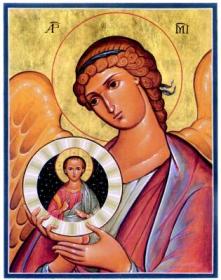
When the days drew near for him to be received up, he set his face to go to Jerusalem. – Luke 9:51
I like to visit parishes on their title feasts. I figure that if anyone knows how to celebrate a feast with proper attention and enthusiasm, it will be a parish named for the feast. This is certainly true of Holy Transfiguration Melkite Greek Catholic Church, where I go every year to celebrate today's feast. Tonight, Fr. Joseph's homily cleared up something I had long wondered about: why the Transfiguration is celebrated on 6 August. Previously, the only theory I had ever heard suggested that this just happened to be the date on which the lectionary reading for the feast (Matthew 17:1-9) fell, but that never seemed very satisfying.
I knew the Lutherans had introduced the practice of commemorating the Transfiguration on the last Sunday before Lent, based on the verse from Luke quoted above. It was shortly after the Transfiguration (Luke 9:28-36) that Jesus "set his face to go to Jerusalem," setting in motion the events leading to his arrest and crucifixion. The Transfiguration provided an appropriate high point from which to begin the Lenten descent towards Holy Week, which was historically as well as liturgically correct. Most other Western liturgical churches subsequently adopted the Lutheran practice, including the Catholics and Anglicans, who nonetheless maintained the 6 August feast as well.
Fr. Joseph told us this innovation actually restored an older practice, in which the Transfiguration was observed shortly before Lent or in its early weeks. (The dedication of the Second Sunday of Lent to St. Gregory Palamas, whose theology drew heavily on the Transfiguration, might preserve this ancient tradition in a less explicit way.) Continuing, Fr. Joseph called attention to the fact that we celebrate the Transfiguration on the 40th day before the Feast of the Holy Cross. Thus, the date maintains the traditional and biblical connection between the Transfiguration and the Cross.
Our focus on the Cross actually began on 1 August, when we commemorated the Procession of the Precious Cross, and will continue through the Octave of the Exaltation of the Holy Cross. This can be seen most clearly on Sundays at Matins, where the appointed Katavasia are those of the Exaltation of the Holy Cross from 1 August through 21 September, with brief breaks for Katavasia of the Transfiguration (7-12 August) and of the Dormition (14-23 August).
My patron saint gets into the act here too! St. Joseph of Arimathea is featured most prominently in the services of Holy Friday, with the commemoration of his removal of Christ from the Cross and burial of Christ. His personal feast day, however, is assigned to 31 July, the Eve of the Procession of the Holy Cross, which maintains his inevitable connection to the Cross.


2 comments:
The icon is a mosaic from an apse at St. Catherine's Monastery, Sinai.
Fr David Bissias gives his thoughts on this subject.
Post a Comment